‘T-Rex’ devours competition — including Raptor
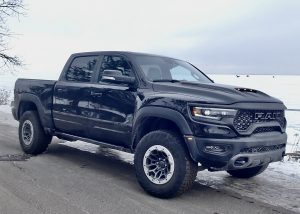
Built to conquer any on- or off-road challenge, the new Ram TRX is armed with a 6.2-liter supercharged V8 with 702 horsepower.
By John Gilbert
Before the surprising warm-up of March descended on the Upper Midwest, it seemed as though we might be headed for the most severe winter ever, with ice-fishing houses out a mile or so from the North Shore of Lake Superior, and wind-chills down in the 40 or 50 below range. A light covering of lake-effect snow had descended as I reached for the door handle of the shiny black Ram TRX pickup I was driving, and a fellow trudging to his pickup nearby said, “Does that thing go through the snow?”
“As fast as you’d like,” I answered.
And that is an accurate assessment. The TRX will go wherever it wants, and you almost feel as though hanging on is the major part of driving it, if only it wasn’t so surprisingly manageable.
Ford has not made many mistakes when it comes to building pickup trucks of all shapes and sizes and potential, but the Dearborn builder of the top-selling vehicle in the country may have misfired on the latest Ford Raptor — the standard of high-performing and rugged pickups specially built to be undisputed King of the Road, or maybe King of the Off-Road.
Enter “dispute,” where none previously existed, because Ram, the brash challenger, has delivered the TRX, which you know is a big hit because its unofficial nickname preceded it: “T-Rex.”
If you look closely, the stylized “R” in TRX wraps around the lower-right corner of the “T” in a manner that just might be intended to look like something out of the Umpteenth Jurassic Park movie, where a giant T-Rex opens its jaws to consume a giant bird — a Raptor, perhaps? — and it holds that pose wherever you spot the TRX logo. Which is on virtually every flat surface, from the engine cover to the tailgate lid and elsewhere. The flair was subdued a bit by the Diamond Black Crystal Pearl-Coat exterior, and black-on-black seems to fit the TRX’s mood.
We are talking prehistoric stuff here, and in a lot of ways the pickup truck wars are somewhat prehistoric. Used to be everybody wanted a car, and the only people who bought pickup trucks were those who needed them, for hauling, farming or towing. So it was easy to distinguish: You bought a car because you wanted one; you bought a truck because you needed one.
That equation has long since vanished, as more and more people want pickups, not only for utilitarian purposes but because they have risen to the upper reaches of style and function, with an over-riding amount of macho attractiveness. Ford’s Raptor has become the favorite among off-roaders, because it comes loaded from the factory with high-output shocks, suspension, front and rear end sustainable parts, and lots of power. The whole Raptor is built wider than the normal F-150. For 2021, a lot of Ford fans were awaiting the new Raptor, and it showed up with Ford’s most potent member of the EcoBoost engine family, a 3.5-liter turbocharged V6 with 450 horsepower and 510 foot-pounds of twin-turbo torque.
Now, 450 horses and 510 foot-pounds are impressive numbers, until you hear the TRX numbers. The spectacular 6.2-liter SRT Hemi V8, supercharged, delivers 702 horsepower and 650 foot-pounds of torque.
That’s on top of the new T-Rex doing the same thing with all the heavy-duty stuff underneath and the rugged, widened demeanor. That 702 horsepower is even brought to life subtly, on a small plaque fastened to the console, for all the world to see. The 702 horsepower is slightly less than the same drivetrain delivers when plunked into the Dodge SRT Hellcat Charger or Challenger sedans/sports coupes, for which it was built, to show dominance against Mustangs and Camaros. But then, the power had to be restrained somewhat in order to resist the mechanical urge to tear away from the heaviest of heavy-duty driveline elements, if you go charging off through the underbrush.
Most buyers might be tempted to do some serious off-roading if they invest in the mortgage-sized tally for a TRX, but obviously most buyers will be satisfied just rumbling down the avenues and highways of our neighborhoods and maybe hit the local shopping center now and then, so being able to handle itself with sophistication on such docile trips is eminently important.
The Ram 1500 TRX Crew Cab 4X4 that I test drove had a base price of $69,995, and was $91,205 once you get it optioned out with the a fifth 365-65 by 18-inch off-roading tire mounted on another 9-inch-wide aluminum wheel at a jaunty angle in the pickup bed, where it is sure to attract attention as well as restrict the amount of stuff you can bring home from Target. Of course, you have the huge rear seat, which also houses more storage underneath, if you can avoid filling the seats with neighbor kids who will want to go for a ride every time they hear that big engine roar to life.
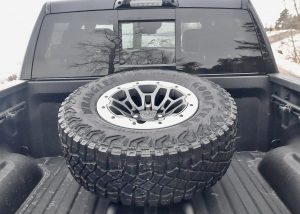
Enormous wheels and tires support the widened and raised TRX, and the fastened spare fills much of the bed.
When the fellows from GSchmitz in Chicago delivered the TRX to my house, they said it took them a little longer, because when they paid for the full-service car wash downtown, the crew apologized and said the enormous wheels and tires on the beast were so large, they wouldn’t fit into the car-wash tracks. So they had to wash it by hand. And none of the young guys in the crew complained, because after dozens of cars and SUVs, the TRX was a true attraction, and they all wanted to get their hands on it, even if just to do some polishing.
The image is definitely macho, as though Ram folks decided that if you’re going to build a truck for the guy or gal who wants an over-aggressive and ferocious pickup, you might as well build one that will stand as the baddest vehicle in the neighborhood. It does have a unique rear backup camera assist that will guide you to backing directly over the tow hitch precisely.
Inside, you are greeted with an 8-speed transmission that will control the SRT, with familiar Ram features such as the huge console, and the large, vertical iPad-style center stack screen for all sorts of information, responding to whatever input you might enter from the remote buttons and switches that pretty well fill the console’s available space and the steering wheel, which is comfortably flattened along the bottom to ease the entry and exit after you’ve climbed — or jumped — aboard. It also has firm-feeling aluminum shift paddles to let you downshift or upshift manually.
For as rugged as it looks, and is, the great refinement built in is much appreciated. I often find the running boards bolted onto pickups are comparatively useless in most cases, but sometimes they help you hop in, or exit without fear of breaking your ankle after the drop when you exit. On the TRX, there is a handy looking cylindrical bar that runs along the bottom of both doors on both sides, but for sturdiness in off-roading, it is so close to the frame that you’d need toes on your boots that are a lot thinner than mine in order to get a foothold. No matter. I mentioned to my wife, Joan, that I felt like I was in better shape after all the high-jumps in and agility-drill exits of the TRX during our week.
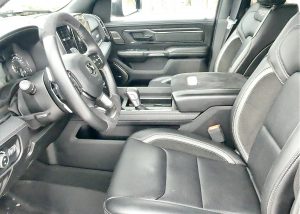
Ram’s win every pickup comparison for interior features, and the TRX upgrades add to the comfort and class.
The lights themselves are a show, with some extra lights for clearance purposes, or maybe because they just look great as accents, glowing out from the functional hood scoop. Up in the cabin, you also have a control knob to select Rock, Baja, Mud/Sand, Custom, Tow, Snow, Auto, and Sport. We dealt mainly with Auto and Sport until the cold was penetrated by a couple of scenic lake-effect snowfalls that tended to glaze the area. The Snow selection left us with no worries.
Same with other high-tech safety things, such as adaptive cruise with stop-and-go, lane-keep assist, pedestrian-cyclist emergency braking, lane-keep assist, blind-spot and cross-path detection, plus real leather on the widened bucket seats, and real carbon-fiber accents, a 19-speaker Harman-Kardon premium audio system, a dual-pane, panoramic sunroof, and enough creature-comforts to tempt you to ignore a cheap motel and sleep in the cabin on a long trip.
If such a trip doesn’t have the convenience of roads or highways, well, the TRX can go through water 32 inches deep, and the special Bilstein shocks coordinate with special coil-spring suspension to allow 13 inches of front-wheel travel and 14 inches at the rear. Ram has always had a clear-cut edge on the competition with its coil springs, which mean the ride, loaded or empty, is always compliant and never harsh.
Harsh no, excessive? Maybe a little. Everything is almost properly excessive with the TRX, including the 11.8-inch ground clearance, and a 33-gallon fuel tank, which is handy, because while you can hammer the TRX for on-road acceleration runs, or take advantage of the 30.2-degree approach and 23.5-degree departure angle off-road, and as the old saying goes, it will pass everything — except a gas station. The EPA estimates are 10 miles per gallon city, 14 highway, and driving somewhat sedately you can coax the on-board computer to top 14. But not by much.
Then again, if you want the baddest of all pickup trucks, and you can spend $91,000 to obtain it, fuel economy may not be high on your list of requirements.


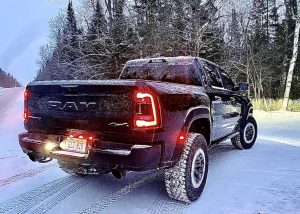
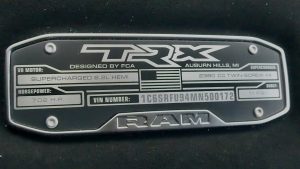
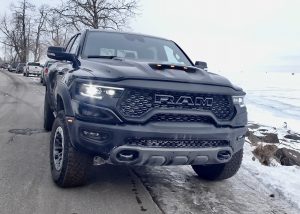
 John Gilbert is a lifetime Minnesotan and career journalist, specializing in cars and sports during and since spending 30 years at the Minneapolis Tribune, now the Star Tribune. More recently, he has continued translating the high-tech world of autos and sharing his passionate insights as a freelance writer/photographer/broadcaster. A member of the prestigious North American Car and Truck of the Year jury since 1993. John can be heard Monday-Friday from 9-11am on 610 KDAL(www.kdal610.com) on the "John Gilbert Show," and writes a column in the Duluth Reader.
John Gilbert is a lifetime Minnesotan and career journalist, specializing in cars and sports during and since spending 30 years at the Minneapolis Tribune, now the Star Tribune. More recently, he has continued translating the high-tech world of autos and sharing his passionate insights as a freelance writer/photographer/broadcaster. A member of the prestigious North American Car and Truck of the Year jury since 1993. John can be heard Monday-Friday from 9-11am on 610 KDAL(www.kdal610.com) on the "John Gilbert Show," and writes a column in the Duluth Reader.